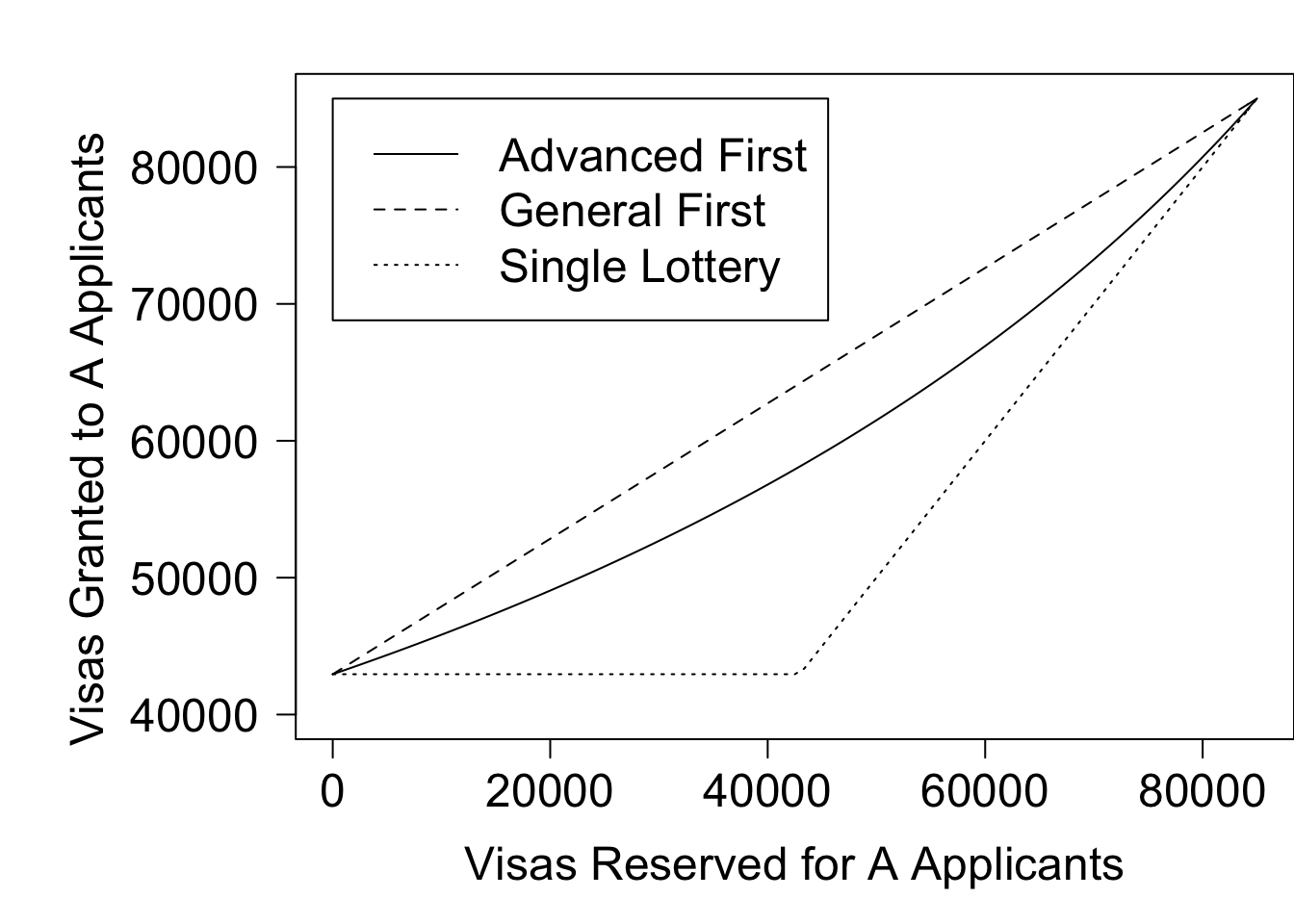Implementation
While this sounds straightforward, in fact there are many ways to implement these quotas. Let's consider several:
Separate Lotteries. Allocate 20,000 visas to A applicants and 65,000 visas to B applicants.
If the USCIS had used this system in 2018, A applicants would have had a lower chance of receiving a visa than B applicants. This runs counter to the intended goal of favoring A applicants. Under this system, A applicants might decide not to declare their advanced degree in order to compete in the B pool.1
Advanced Degree Lottery First. Hold a lottery for 20,000 visas among A applicants. Enter all applicants who have yet to win a visa into a second lottery for the remaining 65,000 visas.
Until this year, the USCIS used this system, which guarantees that A applicants are never at a disadvantage relative to B applicants. The success rates in 2018 were approximately 51% for A applicants (49,000 recipients) and 38% for B applicants (36,000 recipients).
General Lottery First. Hold a lottery for 65,000 visas among all applicants. Enter all A applicants who have yet to win a visa into a second lottery for an additional 20,000 visas.
This is the new system. It also guarantees that A applicants are never at a disadvantage relative to B applicants. In fact, this will always give A applicants a bigger advantage than they had under the previous system. Had the 2018 lottery been conducted in this way the success rates would be approximately 55% for A applicants (53,000 recipients) and 34% for B applicants (32,000 recipients).
Single Lottery. Process applicants in a random order, giving visas when possible. B applicants are only eligible for a "standard" visa. A applicants are eligible for either visa, and take a "set-aside" visa if both are available.
Had the USCIS set out to improve the lot of B applicants, it could have changed to this system. Although this system guarantees that A applicants are never worse off than B applicants, it is worse for A applicants than either of the two preceding approaches. In fact, if this system had been used in 2018, then the success rates for A and B applicants would have been identical at approximately 45%. In other words, in 2018 this would have been equivalent to issuing 85,000 visas without any set-asides for advanced degree holders.2
Figure 1 shows the number of successful A applicants under the latter three systems, as a function of the number of set-aside visas (using application data from 2018, and holding the total number of visas at 85,000).3
V = 85000 #total number of visas
A = 96000 #number of A applicants
B = 94000 #number of B applicants
AV = 20000 #number of visas reserved for A applicants
#One lottery, give reserved visa if possible
single_lottery = Vectorize(function(AV){return(min(max(AV,V*A/(A+B)),A))})
#Process general first
general_first = Vectorize(function(AV){min(A,(V-AV)*A/(A+B) + AV)})
#Two lotteries, process A applicants first
advanced_first = Vectorize(function(AV){return(min(A,AV+(A-AV)*(V-AV)/(A+B-AV)))})
par(mar=c(5, 8, 2, 0))
#Each counts number of A applicants to receive a visa
plot(advanced_first,xlim=c(0,V),las=1,xlab='Visas Reserved for A Applicants',ylim=c(40000,85000),ylab='',cex.lab=1.5,cex.axis=1.5)
plot(general_first,xlim=c(0,V),add=TRUE,lty='dashed')
plot(single_lottery,xlim=c(0,V),add=TRUE,lty='dotted')
title(2,ylab='Visas Granted to A Applicants ',line=5,cex.lab=1.5)
legend(x=0,y=85000,legend=c('Advanced First','General First','Single Lottery'),lty=c('solid','dashed','dotted'),cex=1.5)
Figure 1: Comparison of lottery systems, varying the quota for A applicants. Changing between systems has the same effect as a significant shift in the quota. For example, running the general lottery first with a quota of 35,000 is approximately equivalent to using a single lottery with a quota of 60,000.